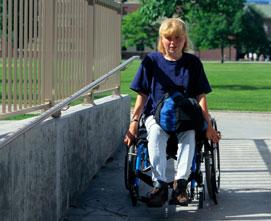What it is
An area of student need, involving difficulty with physically moving.
Teaching Strategies

Instructional
• Implement strategies suggested by a physical and/or occupational therapist.
• Based on recommendations, develop an alternative programming goal related to acquiring, improving and/or maintaining mobility skills.
• Plan activities that will ensure the student’s inclusion and safety.
• Ensure choice of learning activities so that student can select area(s) of strength.
• Modify physical education expectations to meet the student’s needs; consider greater focus on knowledge.
• Teach self-advocacy skills.
• Use assistive and mobility devices.
• Consider accessibility needs when planning fieldtrips.
• Provide breaks to combat fatigue.
Less...
More...

Environmental
• Use preferential seating to allow for easy entry and exit.
• Provide additional room for the student to move between desks.
• Provide access to elevators and ramps.
• Determine emergency evacuation procedures and post these.
• Provide extra time for transition between classes/locations in the school.
• Allow the student to go through the halls when they are less congested (slightly before or after bell).
• Provide access to lockers with extra space.
• Provide availability and usage of accessible washrooms.
• Ensure materials are reachable.
• Provide a large/table desk to accommodate a wheel chair, if used.
• Ensure accessible transportation, including on fieldtrips.

Assessment
• Encourage use of assistive devices.
• Provide a choice of assessment activities for the student to utilize his/her strengths.
Resources
|
Information on standers. |
Information on a variety of assistive devices, including wheel chairs, ramps, guide dogs, etc. |







